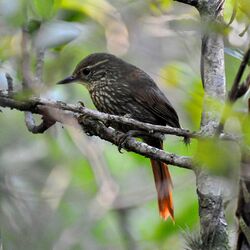Biology:Syndactyla
From HandWiki
Short description: Genus of birds
| Syndactyla | |
|---|---|

| |
| Buff-browed foliage-gleaner (Syndactyla rufosuperciliata) | |
| Scientific classification | |
| Domain: | Eukaryota |
| Kingdom: | Animalia |
| Phylum: | Chordata |
| Class: | Aves |
| Order: | Passeriformes |
| Family: | Furnariidae |
| Genus: | Syndactyla Reichenbach, 1853 |
| Type species | |
| Xenops rufosuperciliatus Buff-browed foliage-gleaner Lafresnaye, 1832
| |
| Species | |
|
See text | |
Syndactyla is a genus of foliage-gleaners, birds in the ovenbird family Furnariidae.
Taxonomy
The genus Syndactyla was introduced in 1853 by the German naturalist Ludwig Reichenbach to accommodate the buff-browed foliage-gleaner.[1][2] The name combines the Ancient Greek sun meaning "together" with daktulos meaning "toe".[3] Members of this genus are most closely related to the foliage-gleaners in the genus Anabacerthia.[4][5] The recurvebills, S. ucayalae and S. striata, were formerly placed in their own genus Simoxenops,[4] and S. roraimae was formerly placed in the genus Automolus.[6]
Species
The genus contains eight species:[7]
- Lineated foliage-gleaner, Syndactyla subalaris
- Guttulate foliage-gleaner, Syndactyla guttulata
- Buff-browed foliage-gleaner, Syndactyla rufosuperciliata
- Rufous-necked foliage-gleaner, Syndactyla ruficollis
- Planalto foliage-gleaner, Syndactyla dimidiata
- Tepui foliage-gleaner, Syndactyla roraimae (formerly placed in Automolus)[6]
- Peruvian recurvebill, Syndactyla ucayalae
- Bolivian recurvebill, Syndactyla striata
References
- ↑ Reichenbach, Ludwig (1853). "Icones ad synopsin avium No. 10 Scansoriae A" (in German). Handbuch der speciellen Ornithologie. Dresden und Leipzig: Expedition Vollständigsten Naturgeschichte. pp. 145–218 [171]. https://www.biodiversitylibrary.org/page/47722872.
- ↑ Peters, James Lee, ed (1951). Check-List of Birds of the World. 7. Cambridge, Massachusetts: Museum of Comparative Zoology. p. 124. https://www.biodiversitylibrary.org/page/14480461.
- ↑ Jobling, James A. (2010). The Helm Dictionary of Scientific Bird Names. London: Christopher Helm. p. 376. ISBN 978-1-4081-2501-4.
- ↑ 4.0 4.1 Derryberry, Elizabeth P.; Claramunt, Santiago; Derryberry, Graham; Chesser, R. Terry; Cracraft, Joel; Aleixo, Alexandre; Pérez-Emán, Jorge; Remsen Jr., J. V. et al. (2011). "Lineage diversification and morphological evolution in a large-scale continental radiation: the neotropical ovenbirds and woodcreepers (Aves: Furnariidae): diversification of a continental radiation". Evolution 65 (10): 2973–2986. doi:10.1111/j.1558-5646.2011.01374.x. PMID 21967436. https://digitalcommons.lsu.edu/cgi/viewcontent.cgi?article=1556&context=biosci_pubs.
- ↑ Harvey, M.G. (2020). "The evolution of a tropical biodiversity hotspot". Science 370 (6522): 1343–1348. doi:10.1126/science.aaz6970. PMID 33303617. https://digitalcommons.lsu.edu/biosci_pubs/3527. A high resolution version of the phylogenetic tree in Figure 1 is available from the first author's website here.
- ↑ 6.0 6.1 Zimmer, K.J.; Robbins, M.B.; Kopuchian, C. (2008). "Taxonomy, vocalisations, syringeal morphology and natural history of Automolus roraimae (Furnariidae)". Bulletin of the British Ornithologists' Club 128: 187–206. https://www.biodiversitylibrary.org/page/45653785.
- ↑ Gill, Frank; Donsker, David; Rasmussen, Pamela, eds (January 2021). "Ovenbirds, woodcreepers". IOC World Bird List Version 11.1. International Ornithologists' Union. https://www.worldbirdnames.org/bow/ovenbirds/. Retrieved 29 June 2021.
Wikidata ☰ Q1060119 entry
 |

